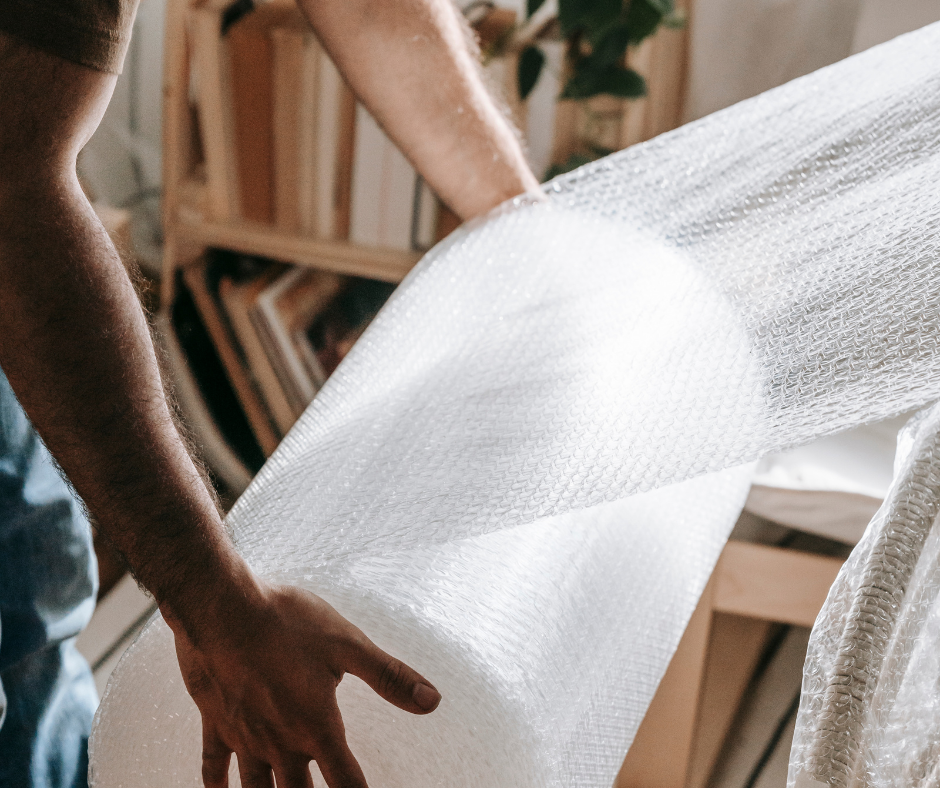Bubble wrap is a beneficial tool for packing and protecting belongings indoors and outdoors. It can be a major advance in safeguarding fragile items like glassware and electronics during a move, as well as weatherproofing and securing outdoor possessions like furniture and equipment.

Maximizing Bubble Wrap Efficiency for Interior Packing
When packing fragile items, it is crucial to ensure their safety during storage or relocation. Making the most of your bubble wrap will ensure that your possessions are well-protected.
Here are a few tips to help you use bubble wrap effectively for interior packing:
1. Wrap items individually:For best safeguarding, encase every delicate item in bubble wrap. This will reduce the possibility of damage during transit and stop them from tumbling against one another.
2. The right size matters:Bubble wrap comes in different sizes, and picking the appropriate one is important. More giant bubbles offer additional cushioning for heavier items, while smaller bubbles are ideal for lighter, more delicate items. When choosing the right size, consider the weight and fragility of your items. Larger bubbles may be suitable for heavier items like electronics, while smaller bubbles are better for delicate items like glassware. Choosing the right size of bubble wrap can significantly impact how well your belongings are protected in transit.
3. Secure bubble wrap with tape: After wrapping your items with bubble wrap, it's important to secure them with packing tape to prevent them from unwrapping while in transit. To do this, encircle the item, and the bubble wrap with the tape to ensure a tight seal. This will add an additional layer of protection and hold the bubble wrap in place.
Be sure to use enough tape to secure the bubble wrap, but not so much that it damages the items.
Weatherproofing and Securing Items with Bubble Wrap Outdoors
Bubble wrap is a multipurpose solution for outdoor use and a tool for interior packing. Bubble wrap can be your go-to option whether you're packing for a move or trying to safeguard outdoor furniture and equipment.
Here are some tips to help you use bubble wrap effectively outside:
1. Protect outdoor furniture:Before putting it away for the winter, consider using bubble wrap to protect outdoor furniture. This is especially helpful for furniture vulnerable to moisture damage and inclement weather, like patio chairs, tables, and loungers. To keep the bubble wrap in place, use tape.
2. Secure items for transport:Use bubble wrap to secure and shield items from the weather when transferring them in an open truck bed or trailer. Individual items should be wrapped, and for added protection, use additional layers of bubble wrap.
3. Insulate plants:Bubble wrap can protect outdoor plants from frost and other harsh weather. This is especially advantageous for delicate flowers or potted plants susceptible to harsh weather. To insulate your plants, wrap the pots or fragile plant parts with bubble wrap. This will add a layer of protection during the winter. Be sure to leave some space for air circulation to prevent moisture buildup.
Creative Uses for Leftover Bubble Wrap
You might have leftover bubble wrap once you've finished packing and unpacking. Instead of discarding it, consider these creative uses for leftover bubble wrap:
1. Insulate windows:During the colder months, cut pieces of bubble wrap to fit your windows and use them as extra insulation. Measure the size of your windows first, then cut the bubble wrap to fit. After that, press the bubble wrap against the window and lightly mist it with water. This can reduce heat loss and energy costs.
2. Protect surfaces:The remaining bubble wrap can be used to cushion delicate surfaces like hardwood floors from slipping rugs or tablecloths. It can also offer additional padding for delicate objects.
3. Cushioning for storage: Remaining bubble wrap can be used to cushion and protect items in storage. Fragile items should be wrapped before being placed in boxes to prevent damage.
Using Bubble Wrap for Moving and Storage
Bubble wrap is an important tool for moving and storing belongings safely. Its padded effect, which absorbs shocks, lessens the chance that your belongings will be damaged during transit. Moreover, bubble wrap is lightweight and easy to use, making it an ideal choice for packing and protecting your items.
Here are some tips for using bubble wrap effectively during a move or while storing items:
1. Wrap fragile items: When packing for a move, consider using bubble wrap to protect breakables like dishes, glasses, and electronics. This will offer additional defense and stop damage while in transit.
2. Cushioning for boxes: Use bubble wrap to line the bottom of moving boxes so fragile items have additional cushioning. Moreover, you can use bubble wrap to stuff voids in boxes to stop goods from moving while being transported. To do this, cut the bubble wrap into small pieces and place them in the gaps between items in the box. This will help prevent the items from shifting during transit, reducing the risk of damage.
3. Protecting furniture: Cover delicate surfaces with bubble wrap to prevent dents and scratches when storing furniture. Protect exposed components such as chair arms, table legs, and other parts during storage by wrapping them.
Eco-Friendly Alternatives to Traditional Bubble Wrap
If you're looking for less harmful substitutes for standard bubble wrap, have a look at these:
1. Recycled bubble wrap: To minimize the environmental impact, choose bubble wrap composed of recycled materials. Because it is made of recycled plastic from post-consumer products, less garbage is dumped in landfills when using this bubble wrap. Nowadays, many businesses sell environmentally friendly bubble wrap that works just as well as conventional varieties.
2. Biodegradable bubble wrap: Consider alternatives to bubble wrap that decompose more quickly in landfills, minimizing their long-term effects on the environment.
Bubble Wrap Dos and Don'ts: Best Practices for Safe Packing
Remember the following dos and don'ts when using bubble wrap to ensure safe and efficient packaging:
Dos:
- Make sure the bubble wrap fits the items you are packing.
- Wrap each item separately to avoid letting contact with other objects damage it.
- Use tape to secure the bubble wrap so it doesn't come undone while in transit.
Don'ts:
- Avoid wrapping things too firmly as this may lead to damage.
- Avoid using strong adhesive bubble wrap directly on delicate surfaces as it may leave behind residue or damage.
To sum up, bubble wrap is a valuable and adaptable packing material used for intelligent packing inside and outside. By paying attention to these pointers and using bubble wrap wisely, you can guarantee the security and safety of your possessions during storage and transportation. Bubble wrap is helpful for clever packing, whether you're getting ready to move or want to weatherproof outdoor items.





